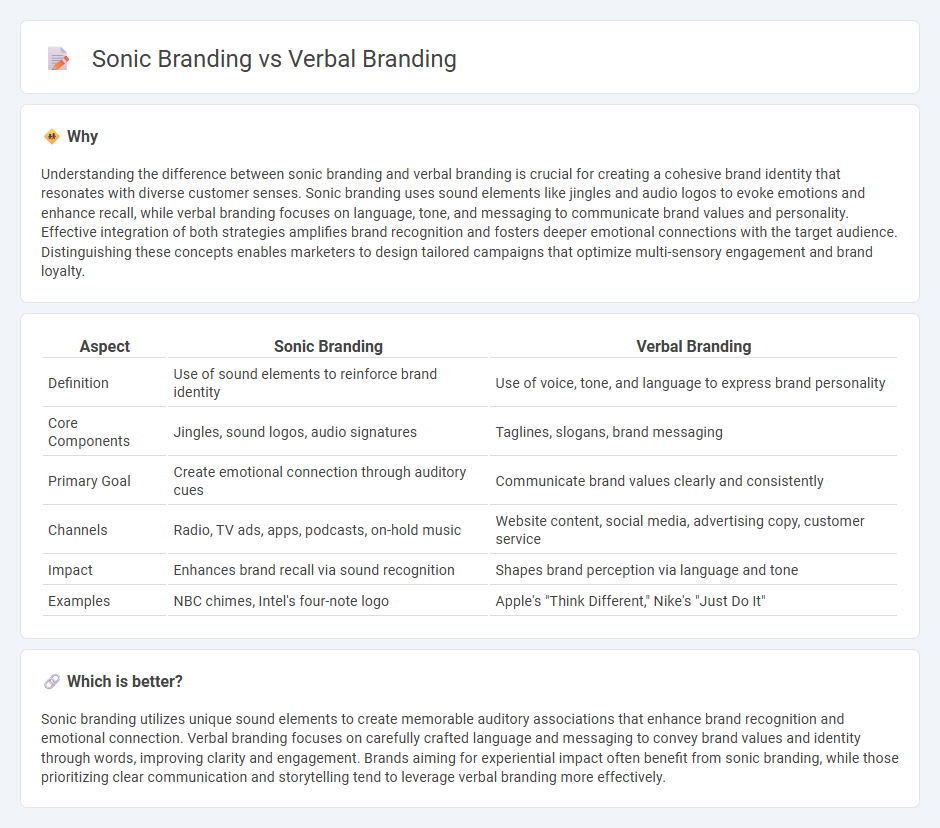
Sonic branding uses unique sounds or melodies to create a distinct audio identity for a brand, enhancing recognition and emotional connection. Verbal branding involves the strategic use of language, tone, and messaging to convey a brand's personality and values through words. Discover more about how these techniques shape brand perception and customer engagement.
Why it is important
Understanding the difference between sonic branding and verbal branding is crucial for creating a cohesive brand identity that resonates with diverse customer senses. Sonic branding uses sound elements like jingles and audio logos to evoke emotions and enhance recall, while verbal branding focuses on language, tone, and messaging to communicate brand values and personality. Effective integration of both strategies amplifies brand recognition and fosters deeper emotional connections with the target audience. Distinguishing these concepts enables marketers to design tailored campaigns that optimize multi-sensory engagement and brand loyalty.
Comparison Table
| Aspect | Sonic Branding | Verbal Branding |
|---|---|---|
| Definition | Use of sound elements to reinforce brand identity | Use of voice, tone, and language to express brand personality |
| Core Components | Jingles, sound logos, audio signatures | Taglines, slogans, brand messaging |
| Primary Goal | Create emotional connection through auditory cues | Communicate brand values clearly and consistently |
| Channels | Radio, TV ads, apps, podcasts, on-hold music | Website content, social media, advertising copy, customer service |
| Impact | Enhances brand recall via sound recognition | Shapes brand perception via language and tone |
| Examples | NBC chimes, Intel's four-note logo | Apple's "Think Different," Nike's "Just Do It" |
Which is better?
Sonic branding utilizes unique sound elements to create memorable auditory associations that enhance brand recognition and emotional connection. Verbal branding focuses on carefully crafted language and messaging to convey brand values and identity through words, improving clarity and engagement. Brands aiming for experiential impact often benefit from sonic branding, while those prioritizing clear communication and storytelling tend to leverage verbal branding more effectively.
Connection
Sonic branding and verbal branding are interconnected through their focus on auditory identity, enhancing brand recognition and emotional engagement. Sonic branding leverages specific sounds, jingles, and music to evoke brand personality, while verbal branding uses tone, voice, and language style to convey brand messaging consistently. Together, they create a cohesive audio experience that strengthens brand recall and differentiates the brand in competitive markets.
Key Terms
Verbal Branding:
Verbal branding centers on the strategic use of language, tone, and messaging to shape a brand's identity and connect emotionally with its audience. It includes brand names, slogans, taglines, and key messages crafted to resonate and foster brand recall. Explore how verbal branding can amplify your brand's voice and presence in the market for deeper engagement.
Brand Name
Verbal branding centers on using a brand name, taglines, and messaging to create a strong verbal identity that resonates with target audiences. Sonic branding incorporates sound elements like jingles, logos, and audio signatures to evoke emotional connections and enhance brand recall. Explore the nuances of verbal versus sonic branding to optimize your brand name's impact.
Tagline
Verbal branding emphasizes the power of a compelling tagline to encapsulate a brand's core message through carefully chosen words that resonate emotionally with the target audience. Sonic branding leverages audio elements like jingles or tones to complement the tagline, reinforcing brand recognition and recall in a multisensory manner. Discover how integrating verbal and sonic branding strategies can amplify your brand's identity and engagement.
Source and External Links
What's Verbal Branding? It's Not What You Think It Is (w/ ...) - Verbal branding is the strategic use of language elements like voice, tone, vocabulary, grammar, and syntax to shape perceptions, foster connections, and express a brand's personality consistently across communication.
The fundamentals of verbal identity - Verbal identity defines how a brand sounds through its unique language and tone, differentiating it in the market and helping build emotional connections and trust with customers.
What is verbal branding? - Verbal branding encompasses every word used by a brand, including content and character, requiring consistent and authentic language use that aligns with the brand's visual identity to foster recognition and trust.
 dowidth.com
dowidth.com